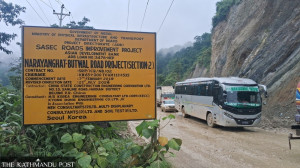Lumbini Province
36-year-old and still incomplete, a Pyuthan irrigation project languishes in disrepair
Lungrimadi Irrigation Project intended to serve 1,200 hectares of croplands in Swargadwari Municipality through a 12-km canal system.
Shamsher Bikram GC
Kunti Devi Bhandari, a 72-year-old woman from Sari in ward 5 of Swargadwari Municipality in Pyuthan, worked for free for the construction of the Lungrimadi Irrigation Project. She was just 36 years old when the project started in 1987.
Now Bhandari regrets over contributing her labour for some days to the project, given that the work is still incomplete even after 36 years.
The Lungrimadi Irrigation Project is an ambitious initiative in Swargadwari Municipality and aims to channel water from the Lungri stream in neighbouring Rolpa district with the objective of irrigating around 1,200 hectares of land in Sari, located in ward 5, Belbas in ward 7, and Baribang in ward 8 of Swargadwari Municipality.
“It was around 38 years ago that the then government announced the project. The locals were overjoyed to learn that they would be able to irrigate their cropfields, which would otherwise depended mostly on rainfall. This is a remote hilly area with no natural source of water, so the locals could grow only a handful of drought-resident crops and the yields would barely sustain them for four months,” said Bhandari.
“Now even after 36 years, the project’s completion is still not certain. As most families here rely on agriculture, many have migrated elsewhere due to prolonged water shortage,” Bhandari added.
According to a ‘progress report’ of the Lungrimadi Irrigation Project, the project was expected to provide irrigation to 1,200 hectares of agricultural land, benefitting over 1,000 residents across three villages of the municipality. The irrigation canal spans 12 kilometres from Lungri stream to Swargadwari, and 75 percent of construction has been completed.
But as the different sections of the constructed canals have not been connected and remain unused, they have deteriorated.
According to Hunaram Bhandari, another local of Sari, during the first five years of the construction of the irrigation canal, all the residents of the three beneficiary villages freely volunteered their labour amounting to around Rs6 million.
“All the three villages and nearby settlements have started to become empty due to migration because the cropfields are not productive. People are now compelled to purchase everything they consume. Cattle rearing has become more challenging.”
He feels that the labour donated by the local residents and the money spent on the project by the government have gone to waste.
“In many places, the canal sections have been washed away by flood or buried by landslides. Broken sidewalls and holes have made the canal useless because they did not carry out maintenance,” Hunaram added.
Saundarya Mani Subedi, the information officer at Swargadwari Municipality, said the census reports show there were more than 1,000 households in the Sari, Belbas, and Baribang villages, but over the past two decades, more than 300 families have migrated from these villages.

Seventy-two years old Bhandari says that during every election, leaders come to her village asking for votes, promising to complete the irrigation project. But once elected, they rarely return.
According to Bidhan Pandit, sub-engineer at the Water Resource and Irrigation Development Division, Pyuthan, under the Ministry of Energy, Water Resource, and Water Supply, so far, Rs131.2 million has been spent on the irrigation project. Similarly, for the current fiscal year, the federal government has allocated Rs3.5 million to repair the canal. Also, the provincial government has allocated Rs1.5 million for a detailed study of the project, including the canal.
Sub-engineer Pandit said that Rs 3.5 million budget would not be enough to repair the canal because a study conducted in the fiscal year 2017-2018 showed that it would cost at least Rs340 million. However, several sections of the canal have worn out further, so it may cost even more.
Pandit emphasised that assessing the repair budget for the canal requires a thorough examination of its condition. “Leaving any structure in disrepair for three decades obviously weakens it,” he said, adding that only after the detailed study will it be decided whether to repair the canal or suspend the project altogether.
According to Gir Bahadur Gharti Magar, ward chair of ward 1 of Swargadwari Municipality, when the canal was about to be ready to supply water, some other development works caused serious damage to the canal.
“A road project in Sunil Smriti Rural Municipality, Rolpa, caused serious damage to the canal, while a 70 metres section of the canal has been swept away by a landslide during the construction of a concrete bridge near Lugrikhola. Currently, a section of more than 360 metres has been found severely damaged,” said Pandit. “Apart from the 360 metres section, several other sections are also in a dilapidated condition, so water cannot be released without repairing the damaged sections,” Pandit added.
“Earlier, several attempts were made to use water from several streams for irrigation, but the efforts proved futile," said ward chair Magar.




 16.57°C Kathmandu
16.57°C Kathmandu














